(Posted 27th May 2022)
| Information Update |
| Chargers, Sponsors and Friends of Rhino Ark, With the 2022 Rhino Charge imminent, it is a good time to reflect upon the first quarter of the year and take stock of progress in our conservation programmes across four ecosystems. Alongside our tangible achievements, there have been challenges, moments of sadness and conservation heroes to appreciate. In early April, the Executive Director, Christian Lambrechts, attended a celebration of the life of Colin Church, a well-attended event at Muthaiga Country Club. Colin, who succeeded Rhino Ark founder Ken Kuhle, was at the helm of Rhino Ark for twelve years and oversaw the commissioning of the Aberdare Electric Fence by the late President Mwai Kibaki in 2009. The completion of this project was a testament to his dedication to the protection of the fragile environment of the Aberdares, and led to his award of the OBE by Her Majesty The Queen. Wildfires Forest fire presented a serious threat to the Aberdares and Mount Kenya ecosystems during the first quarter. In the Aberdares, the first major fire broke out in early February in the north-eastern moorland. The fire destroyed approximately 1,500 acres of vegetation. The second major fire affected 9,000 acres of the catchment area of Malewa River and open forest on the escarpment above Sophia. Over ten smaller fires broke out in the Kipipiri hills and Ndaragwa Forest. “We believe that all these fires were caused by human activity, including arson, charcoal making and even bee-keeping.” says Christian Lambrechts. At the height of the conflagration “there were around 280 people on the ground from the Kenya army, the National Youth Service, our partners from the Kenya Wildlife Service (KWS) and the Kenya Forest Service (KFS) and, together with the Aberdare Joint Surveillance Unit (AJSU) whose work in combatting the fires has been exceptional.” Mount Kenya did not escape the scourge of the fires. In its moorlands and the adjacent forest belt, 700 acres and 18,000 acres of moorland were destroyed. “I’m proud to say that Rhino Ark played a key role in combatting the fires, through training, equipment, fire breaks support and aerial reconnaissance”, comments Christian Lambrechts. “We conducted daily aerial recce of the fires to assist the coordination and planning of the firefighting operations. With the support of our Chairman, Peter Kinyua, we are expecting to soon receive three fully-equipped tractors to create and maintain the vital fire-breaks.” |
 Wildfire in the moorlands of Mt. Kenya, 13 March 2022. Wildfire in the moorlands of Mt. Kenya, 13 March 2022. Extensive wildfires in the northern moorlands of the Aberdares, 23 March 2022. Extensive wildfires in the northern moorlands of the Aberdares, 23 March 2022. |
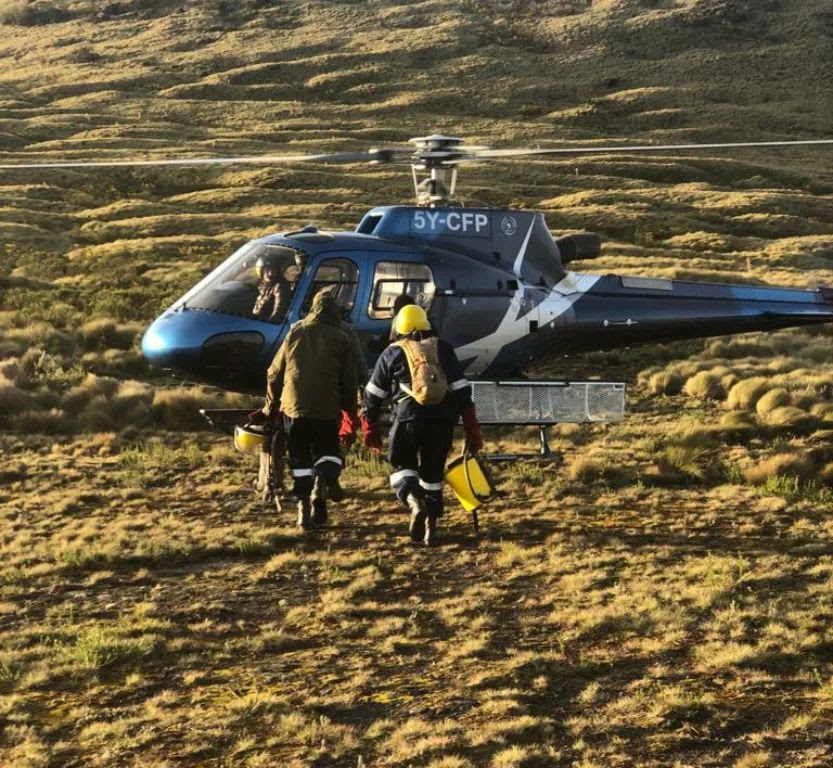 Firefighters walking to board a helicopter to be dropped in the most remote areas affected by the wildlife in the northern moorlands of the Aberdares, with the support of Rhino Ark. |
| Elsewhere in the Aberdares, foot patrols by the Joint Surveillance Unit (AJSU) continued their valuable work of dealing with hotspots of illegal activity. Snaring for bushmeat, firewood cutting, charcoal making and incidents of bamboo cutting for basket-making were dealt with on the ground. While the Northern Sector of the Aberdares was generally clear of illegal activities, the Southern Sector saw extensive illegal logging in Kimakia forest with over 25 trees cut down. Bushmeat and bamboo harvesting were also observed. In the Central Moorlands, AJSU’s tracking patrols found the area generally clear – apart from some marijuana planting. AJSU were quick to uproot the plants. For the fence itself, the day-to-day activity included fence maintenance and the rehabilitation of its oldest sections. Alarmingly, the insidious government proposal to construct a road across the Aberdare National Park has re-emerged. “We have noted with concern that a budget has been allocated in this financial year for the construction and design of the road,” says Christian Lambrechts. “We are watching the situation closely and engaging with the relevant Government agencies.” |
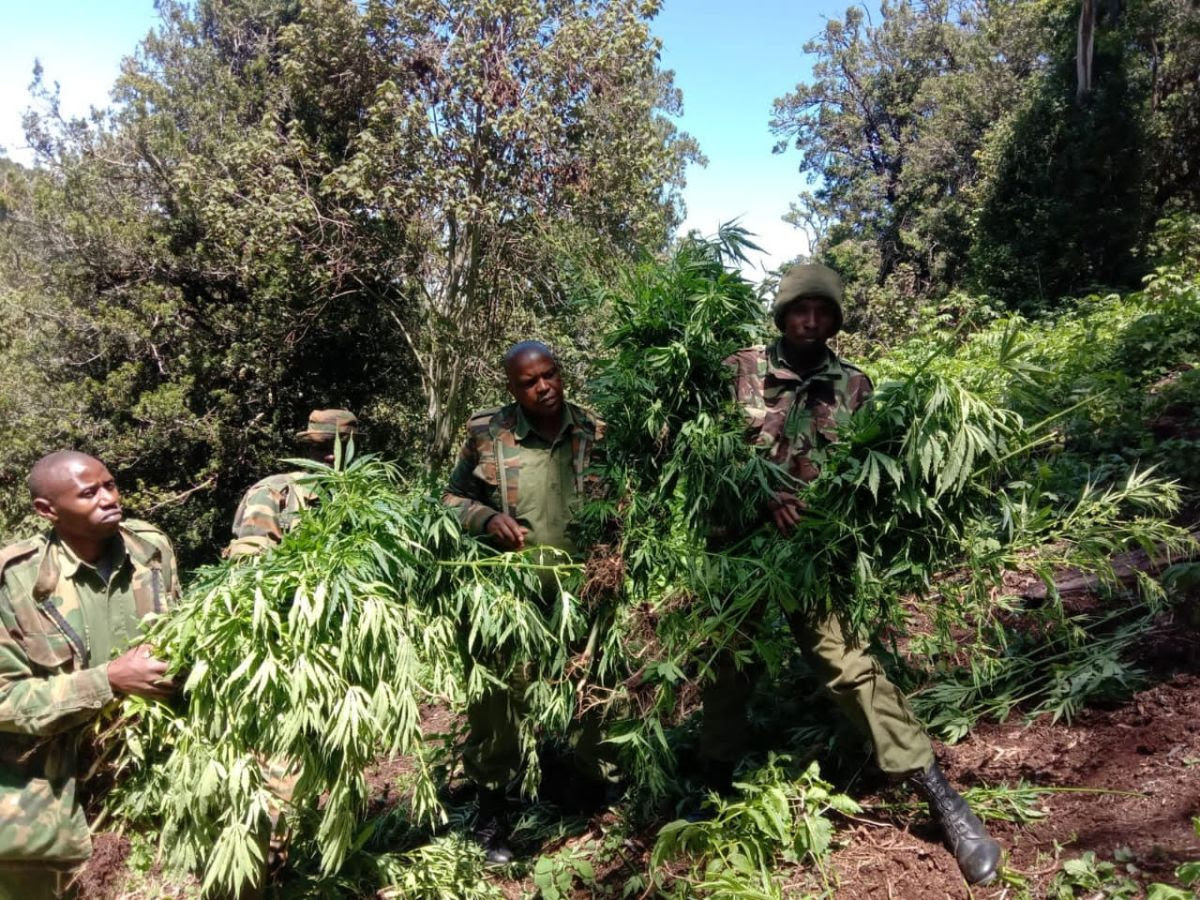 The Aberdare Joint Surveillance Unit uprooting marijuana in the Aberdare forest ecosystem. The Aberdare Joint Surveillance Unit uprooting marijuana in the Aberdare forest ecosystem.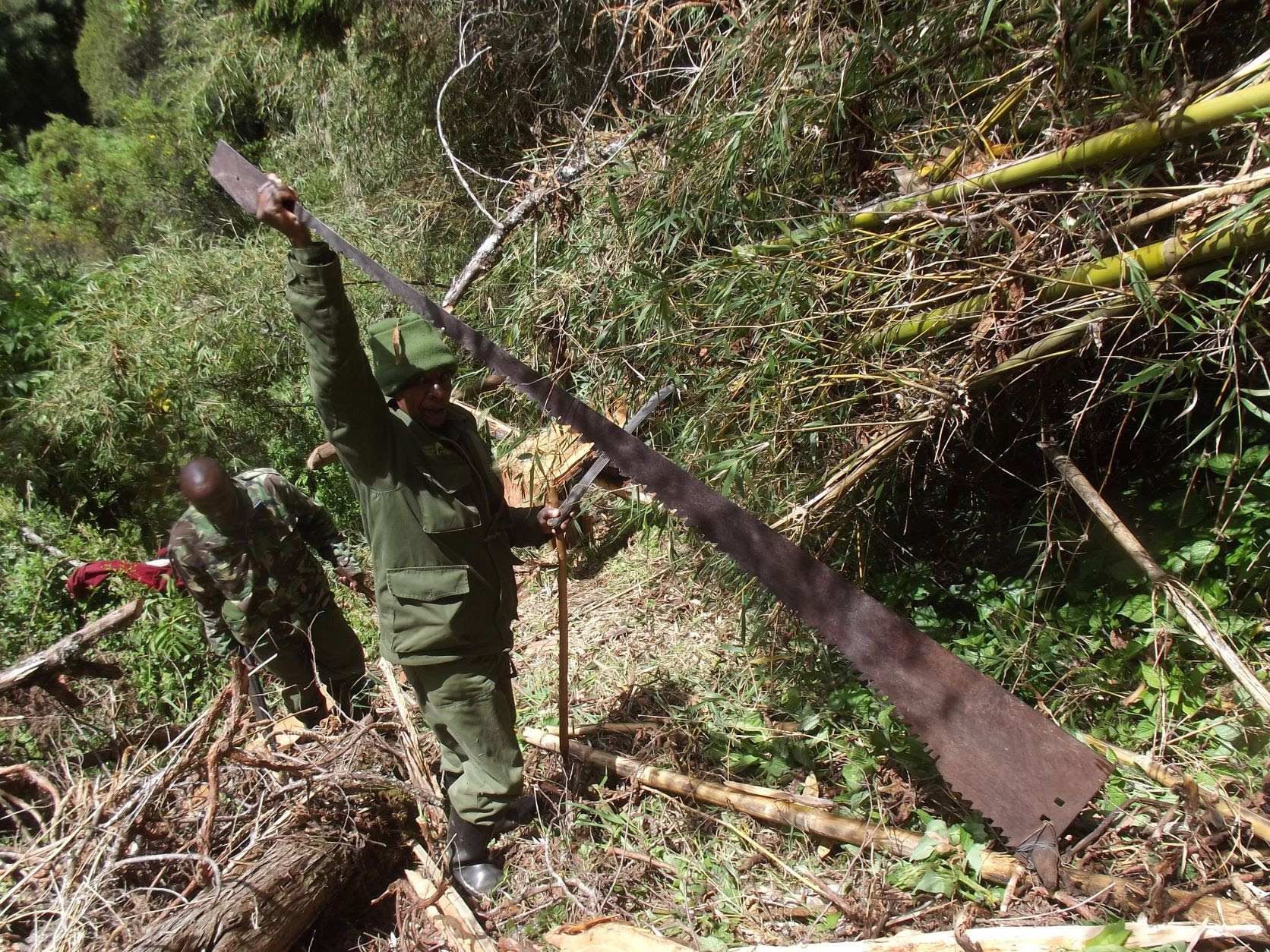 The Aberdare Joint Surveillance Unit recovering tools used for illegal logging in the Aberdares. The Aberdare Joint Surveillance Unit recovering tools used for illegal logging in the Aberdares. |
| Mount Kenya – fence construction. A further 7.1 kilometres of the planned ten-kilometre electric fence around the Mount Kenya Wildlife Conservancy have been built. In Nyeri County, a 60-kilometre-long fence section was launched on 19 November 2021 with Hon. Sicily Kariuki, Cabinet Secretary, Ministry of Water, Sanitation and Irrigation as the Chief Guest. This fence section is progressing well with 21 kilometres already completed. “These are significant developments in these times of financial constraint”, says Christian Lambrechts. An important benefit of the fencing project is that the forest boundary beacons have been re-established by KFS. In Hombe Forest Station, this has enabled KFS to re-possess a 20 to 30 metre wide, two kilometre long, stretch of the forest. Fundraising efforts have also been successful. Rhino Ark has secured USD200,000 (KES 23 million) from Elephant Cooperation, and we are confident that these funds will include a further USD28,000 from the Wildlife Conservation Society to build an elephant underpass under the Nanyuki-Meru highway where it crosses the Imenti Forest, Mount Kenya. In January, stakeholder meetings were held to identify the most appropriate site for the underpass – involving KWS Meru Station, a KWS senior scientist, a KFS ecosystem conservator from Meru County, and Rhino Ark. The consultative process also included a meeting with the Governor of Meru County. The detailed design report has been prepared and submitted to Kenya National Highways Authority. Bongo conservation With funding from the Calgary Zoological Foundation, Rhino Ark is now supporting the Ragati Conservancy in a major conservation effort to secure the remaining bongo population in Ragati and Chehe forests on Mount Kenya. A prior informed consent process has been successfully completed in Chehe Forest Station, resulted in KFS issuing a permit to place 15 camera traps in that forest. A similar process is being undertaken in Ragati Forest. Meanwhile, a breakthrough has been achieved in bongo conservation with the completion of the Mawingu Sanctuary and the release of eight bongo into that sanctuary. This programme, financed by the Mount Kenya Wildlife Conservancy aims to restore captive bongo to the wild and breed them in semi-captive conditions – with their offspring being translocated to re-populate traditional bongo habitats. |
 Hon. Sicily Kariuki (left), Cabinet Secretary, Ministry of Water, Sanitation and Irrigation, Julius Kamau (centre), Chief Conservator of Forests, Kenya Forest Service and Christian Lambrechts (right), Executive Director, Rhino Ark, getting briefed by John Andati (further right), KWS Clerk of Works, on the fence construction process at the launch of the 60-km-long Mt. Kenya fence section in Nyeri County. |
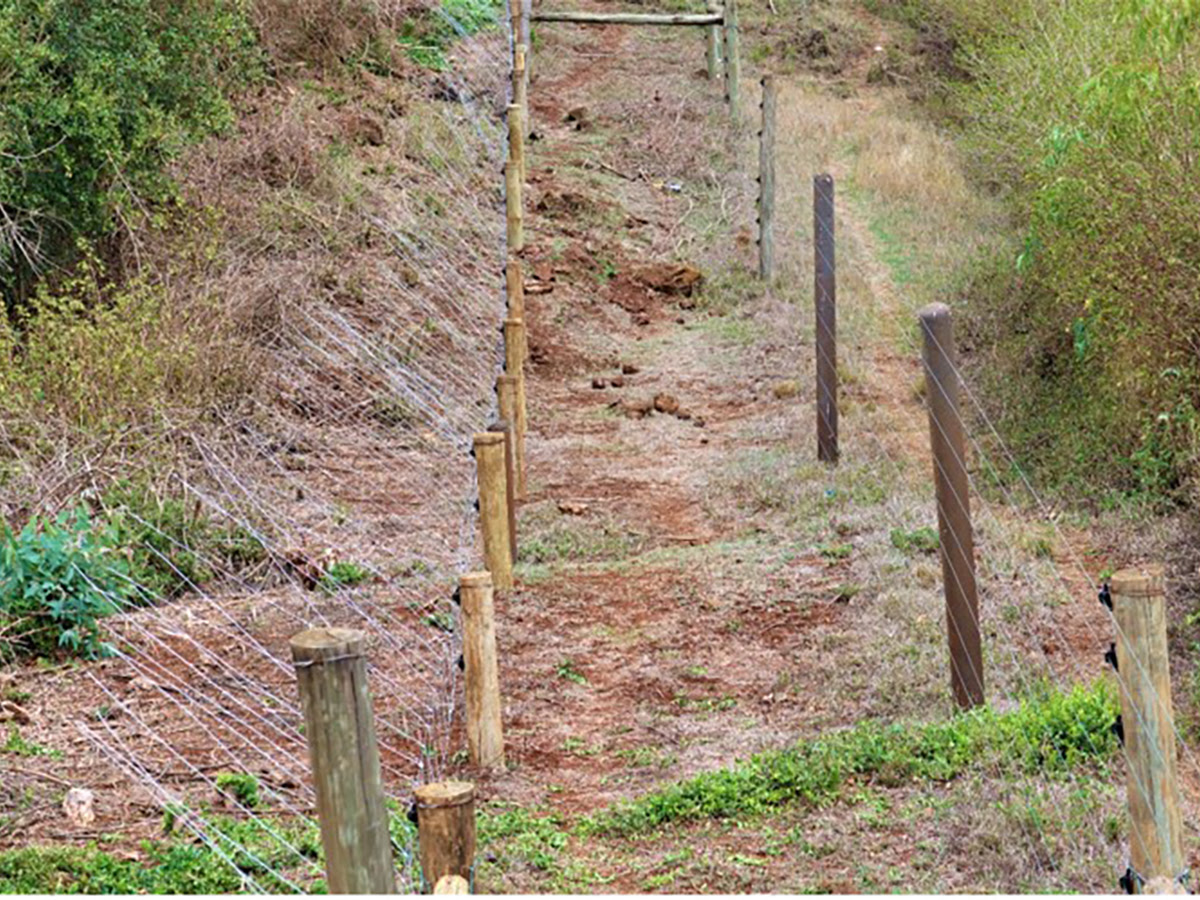 30 kilometres of low fence with outriggers have been built along the main electric fence to prevent elephants from marauding onto adjacent farmlands. 30 kilometres of low fence with outriggers have been built along the main electric fence to prevent elephants from marauding onto adjacent farmlands.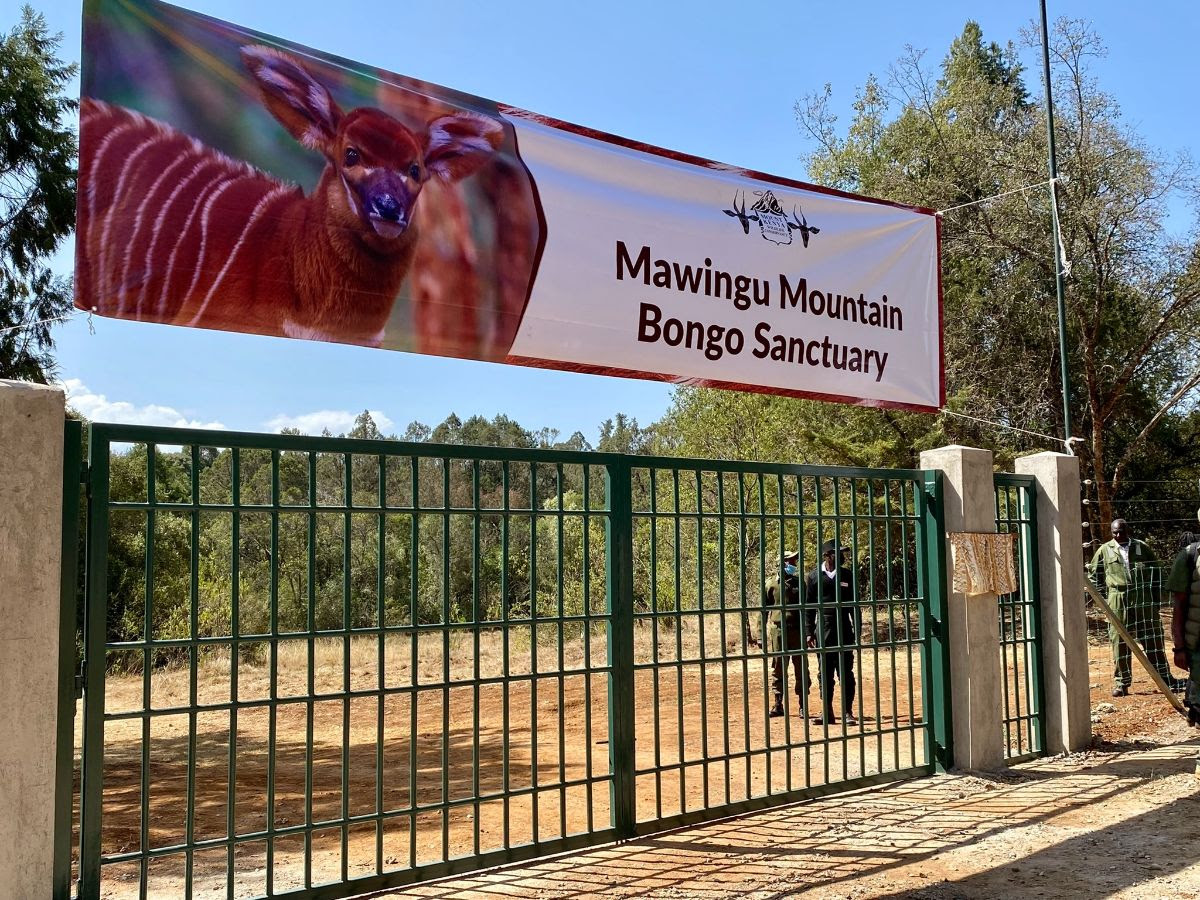 Entrance of the Mawingu Mountain Bongo Sanctuary commissioned by Hon. Najib Balala, Cabinet Secretary, Ministry of Tourism and Wildlife. Entrance of the Mawingu Mountain Bongo Sanctuary commissioned by Hon. Najib Balala, Cabinet Secretary, Ministry of Tourism and Wildlife. |
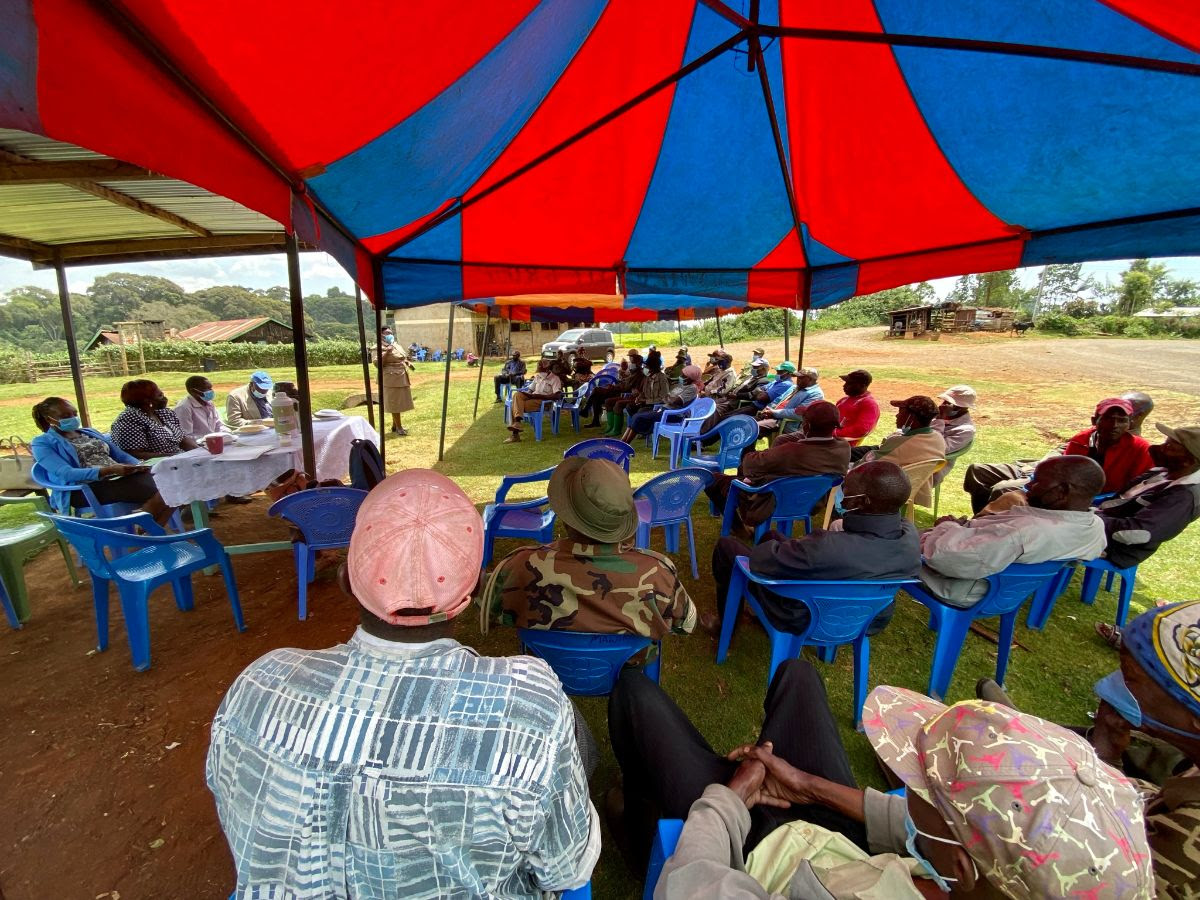 Prior Informed Consent process conducted with the Chehe Community Forest Association. Prior Informed Consent process conducted with the Chehe Community Forest Association.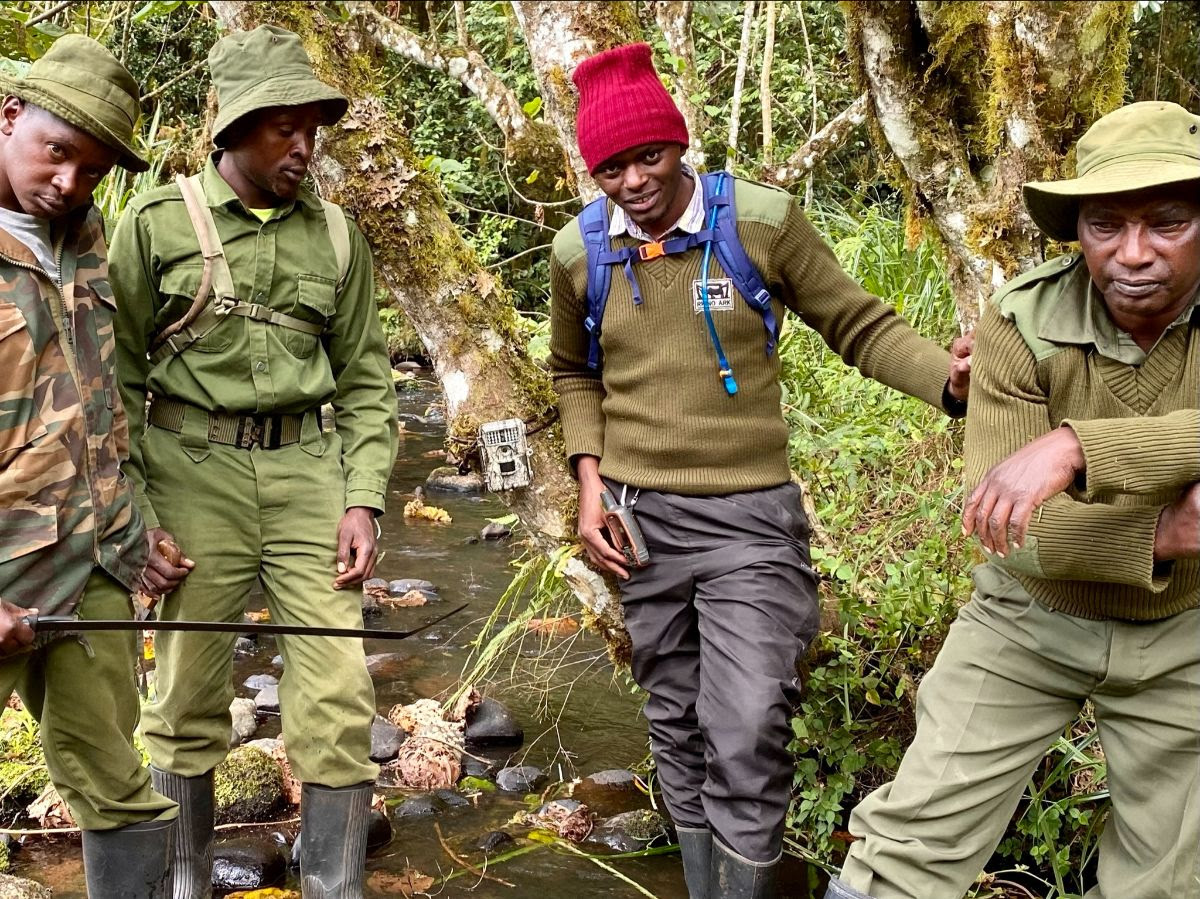 Community trackers, supported by the Rhino Ark / Calgary Zoo Mountain Partnership, placing camera traps in Chehe Forest, Mt. Kenya. Community trackers, supported by the Rhino Ark / Calgary Zoo Mountain Partnership, placing camera traps in Chehe Forest, Mt. Kenya. |
| On Mau Eburu Mau Eburu did not escape the menace of forest fires in the first quarter of 2022. From January to 22 March, a total of nine forest fire incidents occurred with 400 hectares destroyed, including 300 hectares in the Ole Sirwa-Morop area where Rhino Ark played a pivotal role by providing supporting logistics and community mobilisation. “Motivating the local communities has been a triumph for us”, says Christian Lambrechts. Weekly forest patrols and de-snaring programmes by community scouts and forest rangers are ongoing. A total of 40 days of intensive patrolling were carried out, resulting in the removal of 40 snares and the dismantling of six charcoal kilns. “The Community Conservation Champions’ Programme is growing in size and scope”, says Christian Lambrechts. “Membership is now up to 16 volunteers spearheading conservation activity under Rhino Ark’s guidance.” In addition, 681 new members have been recruited for the Community Forest Association. Under the community livelihoods programme, 91 farmers received on-farm training during the period. Knowledge gained included organic farming, dairy farming best practices, kitchen gardening and use of biogas. Through the beekeeping development programme, the Eburu Natural Forest Honey Cooperative Society Limited was registered with the support of Rhino Ark. The cooperative has already a total of 55 community members and the number is growing. Members have received capacity building training. Under the ecotourism and conservation knowledge capacity building programme, Community Conservation Champions have received training on bird watching and forest plants. To support recreational use of the forest, the 14.6 kilometres of forest trails are being maintained with support from Eburru Rafiki and Rhino Ark. |
 Burnt leleshwa bushland in Eburu Forest. Burnt leleshwa bushland in Eburu Forest. Community members and rangers fighting wildfires in Eburu Forest. Community members and rangers fighting wildfires in Eburu Forest. |
 Buffalo cable trap dismantled by community scouts supported by the Rhino Ark / Calgary Zoo Mountain Forest Partnership. Buffalo cable trap dismantled by community scouts supported by the Rhino Ark / Calgary Zoo Mountain Forest Partnership. Charcoal kiln destroyed by community scouts supported by the Rhino Ark / Calgary Zoo Mountain Forest Partnership. Charcoal kiln destroyed by community scouts supported by the Rhino Ark / Calgary Zoo Mountain Forest Partnership. |
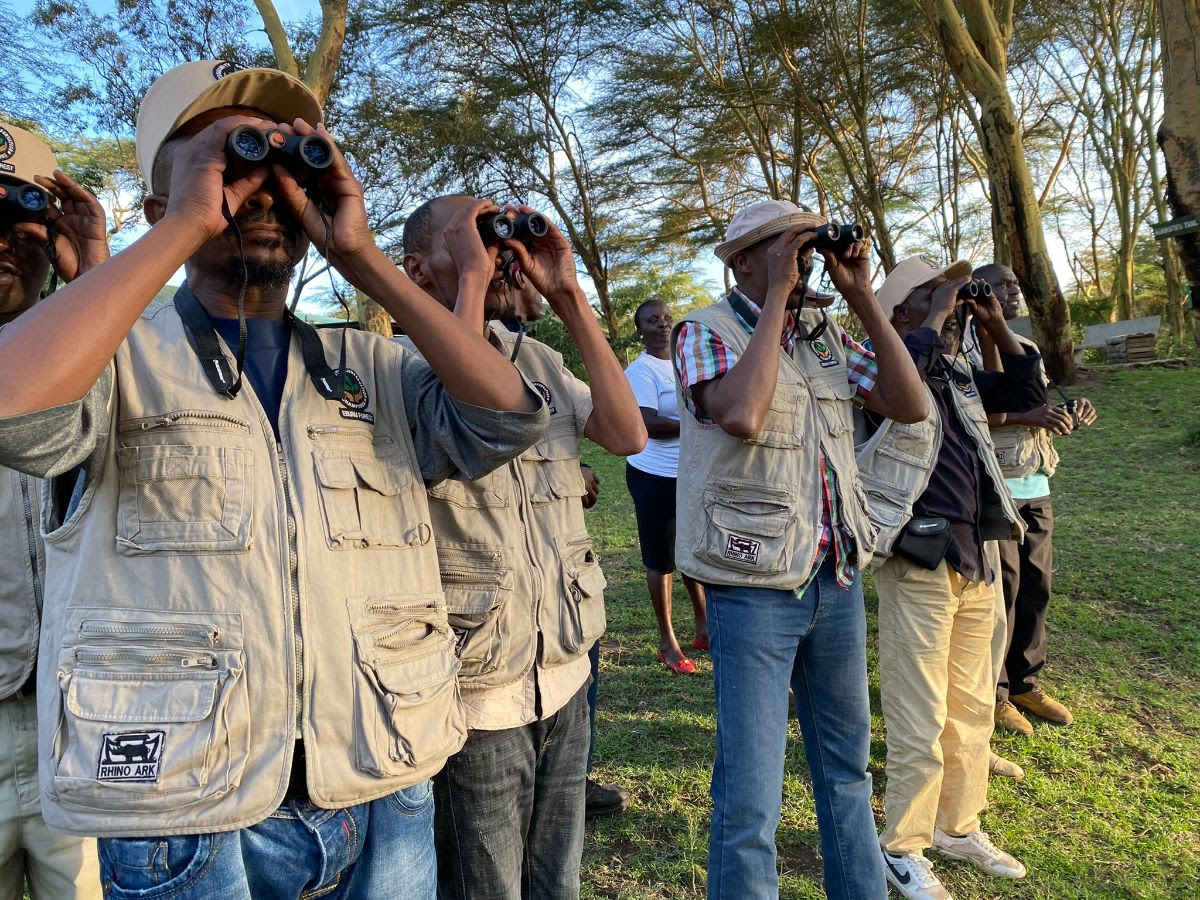 Eburu Community Conservation Champions being trained in bird watching. Eburu Community Conservation Champions being trained in bird watching. Members of the newly established Eburu Natural Forest Honey Cooperative Society Limited trained in honey harvesting. Members of the newly established Eburu Natural Forest Honey Cooperative Society Limited trained in honey harvesting. |
| Schools’ conservation education and tree nursery programmes The model tree nursery at Kahuho Secondary School in Kiambogo is now fully operational, actively maintained by pupils. Construction of a new tree nursery at Munanda Secondary School in ongoing. Through the schools’ conservation education programme, Rhino Ark convened and facilitated the annual Conservation Curriculum Implementation Committee Workshop in January 2022. This forum brought together 17 participants including teachers, officials from the Ministry of Education, KWS, KFS, community Conservation Champions and local administrators. “This forum provides an essential platform to share experiences and strengthen the programme”, comments Christian Lambrechts. Eburu-Lake Naivasha wildlife corridor Security within the wildlife corridor has been greatly improved with the establishment of a permanent team of two KWS rangers based at the Naitolia joint patrol camp. They work in collaboration with members of the forest community surveillance teams and security personnel from the large farms within the corridor zone. Mobility has been greatly improved through the provision of a motorcycle with running costs contributed by local landowners. |
 Participants in the annual Conservation Curriculum Implementation Committee Workshop held in January 2022. Participants in the annual Conservation Curriculum Implementation Committee Workshop held in January 2022.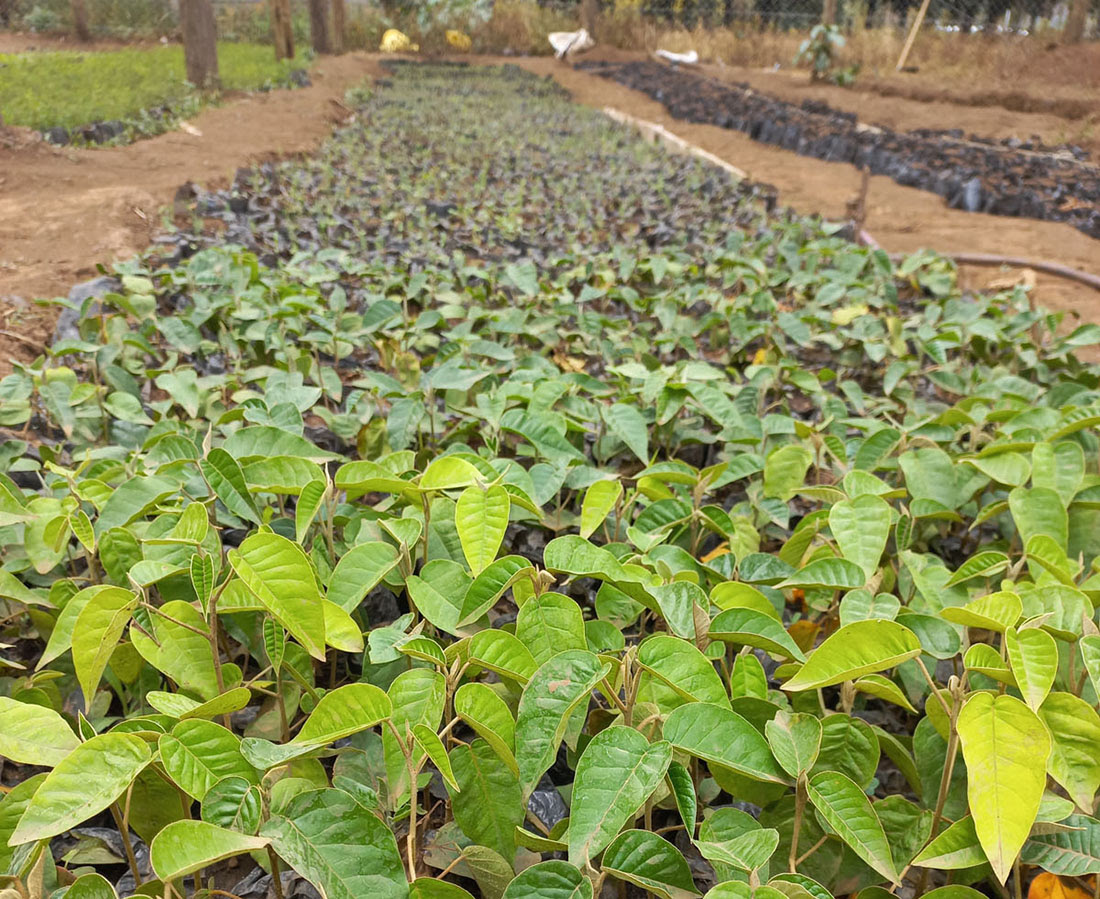 Indigenous seedlings (croton) in Kahuho Secondary School’s tree nursery. Indigenous seedlings (croton) in Kahuho Secondary School’s tree nursery. |
| South Western Mau Active maintenance of 50 hectares of Rhino Ark replanted forest comprising 40 hectares at Kipkoris forest outpost and 10 hectares at Kapkembu forest outpost is ongoing. These sites, which are micro-fenced, are in good condition with planted seedling survival at over 80 percent. With the recent donation of KES 6 million by Platinum Credit Ltd, work has commenced to replant 40 hectares of indigenous forest at Tirigoi area. Two forest patrols were carried out in the first quarter, with 3 snares recovered. In the April-May period, 4 forest patrols recovered 4 snares and destroyed 1 illegal charcoal kiln. Encouraging too, was the fact that Rhino Ark’s aerial surveillance flight conducted in December 2021 observed a significant reduction in illegal activity in the forest below. Nineteen community conservation outreach meetings were held during this period and groups engaged included local churches and Conservation Champions. The schools’ conservation education programme covering 46 forest adjacent schools is progressing well. Building upon the successful curriculum launch event held last October, review of the schools was done through support visits. “This is a way forward for Kenya conservation”, says Christian Lambrechts. “The enthusiasm for conservation shown by the schools through this programme is hugely encouraging.” Bee-keeping is a growing industry and Rhino Ark has facilitated rehabilitation of ten community beehives in the Kipkoris area. Ongoing technical support for local community groups has stimulated the growth of the community-based tree nursing programme. Twenty-eight tree nurseries have been set up through this initiative. The burgeoning community conservation champions development programme continues to be a cornerstone for the community engagement strategy, with nine active volunteer members supporting outreach, community mobilization and monitoring of schools. |
 Thomas Mutai (left), Rhino Ark Outreach Officer/South Western Mau, assessing the impact on fuelwood consumption of an improved stove installed by Rhino Ark in Kipkoris Secondary School. Thomas Mutai (left), Rhino Ark Outreach Officer/South Western Mau, assessing the impact on fuelwood consumption of an improved stove installed by Rhino Ark in Kipkoris Secondary School.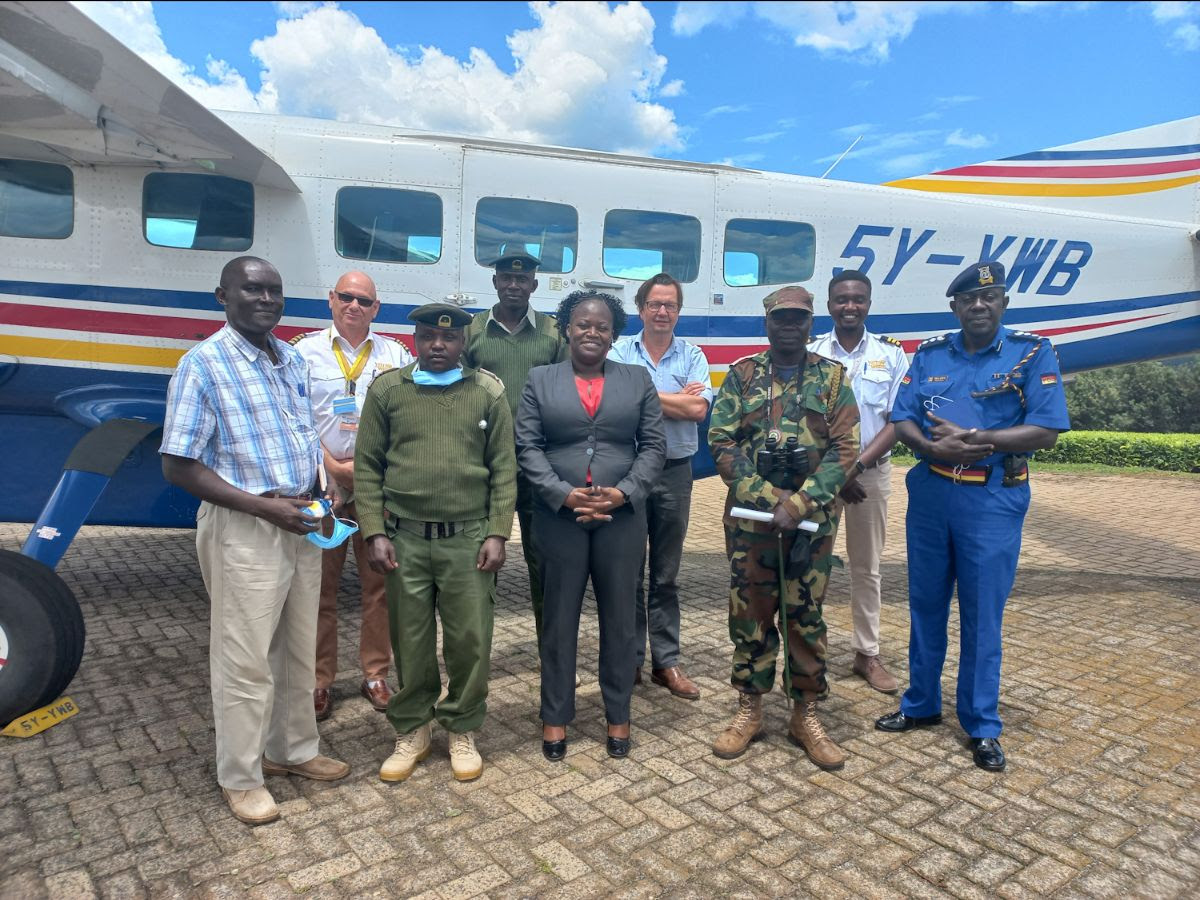 Team that participated in the aerial surveillance above South Western Mau Forest. Team that participated in the aerial surveillance above South Western Mau Forest. |
 Degraded forest at Tirigoi area (South Western Mau Forest) to be rehabilitated with the support of Platinum Credit Ltd. Degraded forest at Tirigoi area (South Western Mau Forest) to be rehabilitated with the support of Platinum Credit Ltd.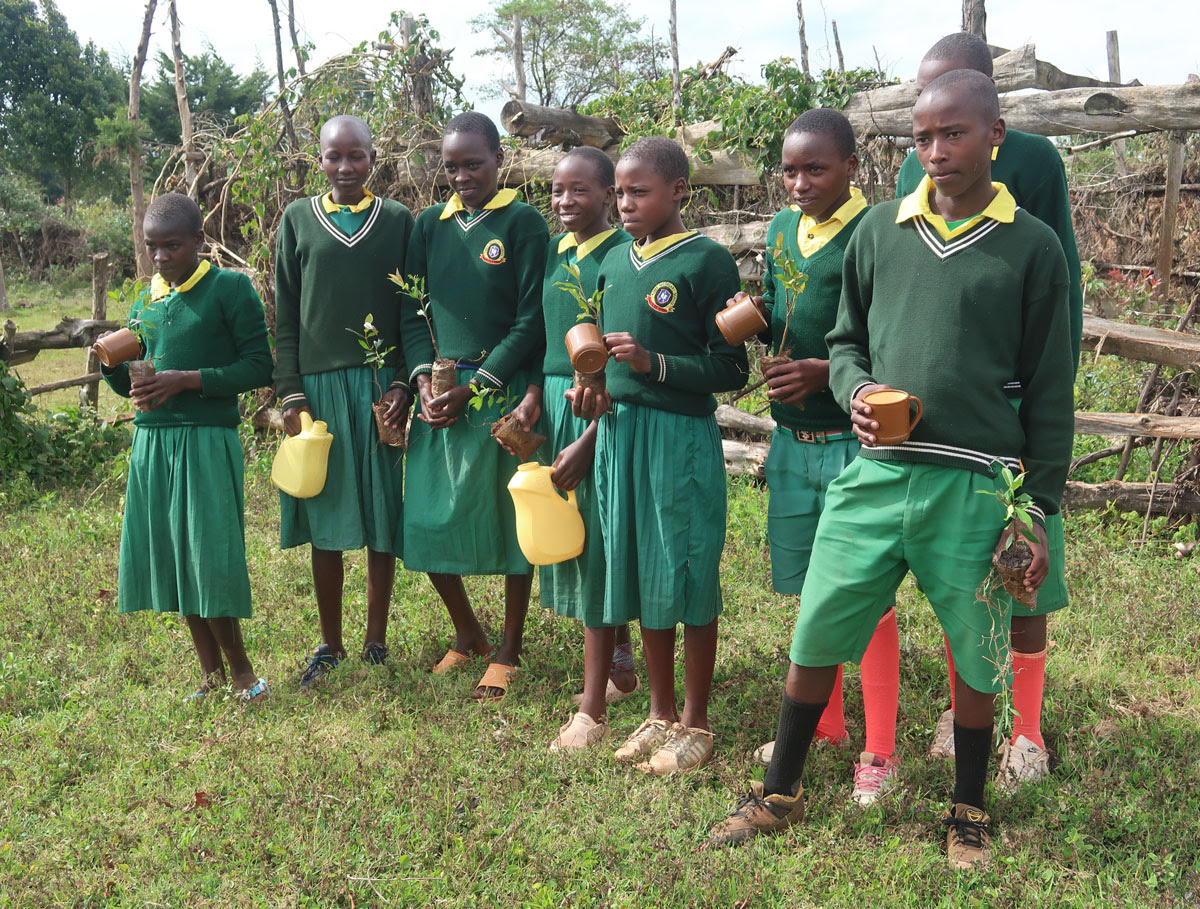 Pupils from Kures Primary School (located near South Western Mau Forest) involved in the tree nursery project. Pupils from Kures Primary School (located near South Western Mau Forest) involved in the tree nursery project. |
| Other developments Rhino Ark has submitted a concept proposal for the establishment of a 158,000-hectare conservation area in the southern part of the Mau Forest Complex to a team of consultants from the European Union, tasked to identify suitable projects to be funded by NaturAfrica. The objective of the proposal is to provide new employment opportunities to forest-edge communities, including from eco-tourism, whilst further restoring and protecting the forest. Three meetings have been held with the team of consultants. Funding requested amounts to approximately € 8 million, and the Rhino Ark proposal was well received. Following the signing of a Framework Agreement between KWS, KFS, Rhino Ark, Mount Kenya Trust and Space for Giants in March last year, a feasibility study for the development of a carbon project for Mount Kenya, Aberdare and Laikipia region is well underway. Rhino Ark is co-financing the feasibility study at a discounted rate with the Mount Kenya Trust and Space for Giants. Public relations and fundraising We are working closely with our Rhino Ark UK office in the development of a PR strategy for Rhino Ark with brand development and greater use of social media channels. “We have had marked success with key media at home”, says Christian Lambrechts, “and we are now looking to present Rhino Ark internationally as an example of the steps a developing country can take to combat climate change. We are strengthening Rhino Ark in the United States and together with the UK office and the parent office here in Kenya, we will have a powerful promotional triumvirate for Rhino Ark.” The Rhino Charge The Rhino Charge, now restored after the Covid-19 setbacks, will take place on Friday 3rd June. “The Rhino Charge has been the mainstay of our fund-raising efforts in the past,” comments Christian Lambrechts. “But the expanded scope of Rhino Ark’s work across four active ecosystems and one upcoming project in Kakamega Forest calls for significantly more resources than can be provided by this event. Our fund-raising in Kenya and the UK, paired with efforts in the USA (where there are major opportunities for support), are now supplementing the Rhino Charge contribution. For all these reasons we can look back on a successful first quarter of the year.” |
0






